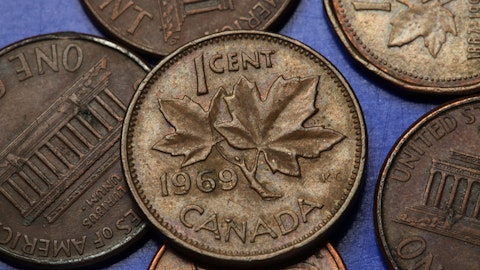Scott Burrows: Yes, Rob. If you look back at — say over the last 18 months, there’s been a fair bit of M&A activity in Canada on the asset side. And I think what we’ve seen historically has been, new acquires tend to deploy more capital than previous owners, whether that’s to make their transactions go around or that’s obviously what they believe in at the time of the transaction. And so, we have found M&A over the last 18 months to actually be an acceleration; you’ve seen that in the increase utilization across the PGI asset. So, Chevron is a great Counterparty but we would expect potentially higher volumes over the relatively near future through an acquisition of a third-party.
Robert Catellier: Okay, thank you. And congratulations on all your business momentum.
Scott Burrows: Thank you.
Operator: And your next question comes from the line of Satish [ph] from Wells Fargo. Your line is open.
Unidentified Analyst: Thanks. I guess two more questions here on the Dow agreement. So the supply agreement of 50,000 barrels, as you mentioned, I mean, that’s not the full ethane supply, I think it’s only about half of the crackers [ph] needs. And I guess I’m just struggling to think about who could satisfy the balance of the ethane, just given your position. But I guess even if there’s another 50,000 barrels of ethane coming from other plants in the region, can you still pick up a benefit by moving some of that third-party supply through your pipelines?
Scott Burrows: Yes. Again, we don’t have line of sight to where the rest of ethane is coming from, and in what phase and what timeline; so potentially a question for others. But depending on where that ethane comes from, we would have an opportunity to move in on our pipelines. Again, we have the only C2 plus pipeline in operations today, gathering lines. And so when we have a pretty big frac footprint, so there is the potential; but at this stage we don’t — we’re not aware of where the next — or where the rest of the ethane is coming from.
Unidentified Analyst: Got it. And then, kind of second question on this project. I mean, you talked about the potential to produce more propane and butane from increasing the NGL cut on your plants for the project. I guess, how are you thinking about the end markets for this incremental supply of C3 pluses there? Maybe enough to consider an LPG export dock expansion or will it get railed into the US?
Chris Scherman: It’s Chris here. Yes, right. We certainly are tracking that closely and recognize that with the ethane will come more propane and butane. It’s likely that it’s going to find a path for the West Coast; so we’re back revisiting what we can do at our facility. We’re looking at what others are doing and watching that closely. And I think it will inevitably spur something on the West Coast.
Unidentified Analyst: Got it. Thank you.
Operator: And your next question comes from the line of Robert Kwan from RBC Capital Markets. Your line is open.
Robert Kwan: Good morning. If I can stop and start with the topic of the day [indiscernible]. So you talked about the potential to DF [ph] on the front of RFS III. What other capital should you see going into the system whether it’s compression or deep heads out in the field? And just under the agreements and with Dow, given you’re still working through the cost of everything — does the agreement specify return on the capital or are you taking the risk on how all of this capital needs to come together within whatever fee you’ve agreed with Dow?
Scott Burrows: Rob, you know, I have to be careful with what I say because we have, obviously, confidential arrangements. But we are obligated, it is a supply arrangement, so we’re obligated to provide the ethane. We are — again, going back to the initial comments; we have a mix here where a significant portion will come from existing assets or very light capital touch to existing assets. And then in terms of the new supply, we do have a mix. And so, you pointed out potentially — you know, as an example, incremental deep cuts, RFS III. There is other opportunities that we just can’t talk about at this stage that we’re exploring. And so for us, it’ll be about how to get the most ethane for the least amount of cost; and that’s something that we’re currently assessing right now.
And I know there’s a lot of questions on it but we’re just not at the stage where we can provide that detail. And we’ll look to do that once we make some of these decisions on a go-forward basis. But it will be an overall mix of existing assets, light touch brownfield, and then some incremental greenfield investments.
Robert Kwan: Got it. And Scott, can I just square your comments here, though up with an answer earlier that if the market is caught short, and there is a need to go out and attract ethane supply at a high price — I know that most of ethane has cost of service in the province but if you have to do that there was the same that is going to be borne by Dow. So how does that square up just in terms of your obligations to supply?
Scott Burrows: Yes. Sorry Rob, I’ll clarify my comments. What I meant was that the cost — the pass-through to ultimately the producer who is was providing the ethane; there is an arrangement there. But it’s a supply agreement, and we have the obligation to supply; so we have a capital cost element to that but there is — the prices is fixed.




